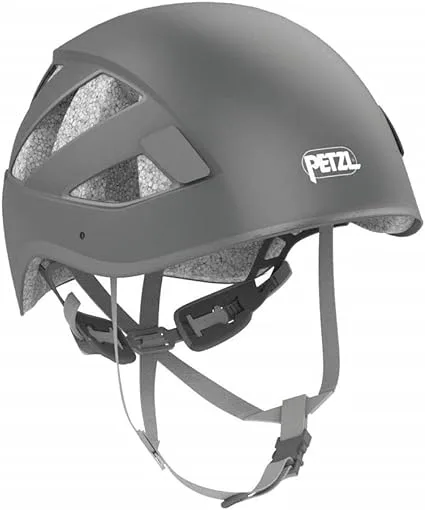Earth
10 Types of Rappelling Gear [Ultimate Beginner Guide]
The most challenging part of mounting a cliff face isn’t necessarily the ascent, despite popular assumptions. After all, you can regulate that process using a variety of procedures and equipment to ensure maximum safety.
When it’s time to drop, though, anxiety often rushes through your veins. A single rappelling system is commonly used to descend. If the climber utilizes it incorrectly, they risk catastrophic injury.
Rappelling is the art of scaling down near-vertical surfaces, including cliffs, dynamically and efficiently utilizing rappelling gear such as ropes, anchors and harnesses, etc.
Even though it’s a controlled descent of a steep rock face, it’s possible to rappel successfully in any weather condition whatsoever as long as the weather conditions are reasonable.
This means that you can even use ice to rappel on without requiring a rescue party to search for you.
Rappelling isn’t the most challenging exercise in the world, but it’s not exactly a picnic either. It takes a lot of energy, determination, and bravery.
And, no matter how skilled or fearless you are, a lot depends on the rappelling equipment the descender has. This is why wearing the correct rappelling gear is imperative for this adventure every time you set out!
Here are 10 essential rappelling gear that you should add to your ‘must have’ list!
Table of Content
1. Ropes

When talking about rappelling ropes, you can’t just talk about them being the safest method to move from one side to another side of a mountain.
They go far beyond that, and they aren’t just the ropes you use for your descent, but they also serve as a precaution to keep you safe.
Most people don’t realize that the proper line with the correct weight, length, and material is all it takes to keep you safe and sound during your descent.
Here’s some information about line types that exist and what they can do for you:
- The S-curved design: The most common type of line to look at is the S-curved one as it features a cross-section of the cord, which is cut at an angle and stitched in a manner that forms a loop with no “walls” or bends in it. The main benefit of this rope type is that you can use it for various belay devices without complications. Bends in the line mean you have to adjust your hold a bit.
The S-curved design also makes it lighter than other rope materials (such as carbon fiber). Another fantastic thing about this line is that the weight is evenly distributed across its entire length.
This way, the weight sticks evenly on each side, and you don’t have to strain at the corners to keep it tight. The S-curved line is also lightweight, ideal for people with limited space to carry all their gear and tools.
- The dynamic climbing line: Another type of rappelling line that is growing in popularity is the dynamic climbing line. The main difference between S-curved and the dynamic climbing rope is how they are constructed. Dynamic climbing ropes are more flexible and typically made of a single material. They aren’t as thick, but the material is quite durable, and it fits well.
2. Anchors
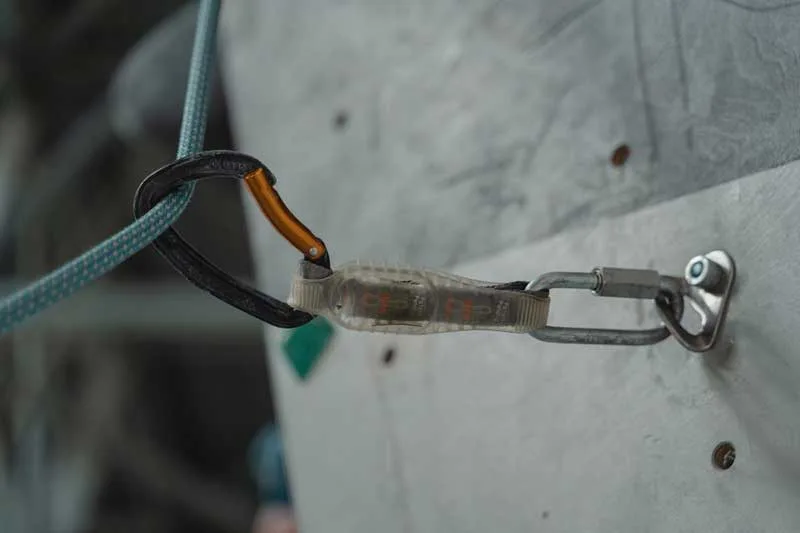
Rappelling anchors are a mandatory part of rappelling equipment that you should carry, or at least be able to rent as part of their overall basic rappelling gear.
Whenever possible, it’s always a good idea to have several different types of rappelling anchors in your backpack. You can then have one ready to deploy when the situation calls for it.
Always remember to view the terrain conditions of any area you’re going to rappel from before you leave home.
It is crucial to ensure you can safely use all of the rappelling anchors you take with you. Failure to check everything in advance could lead to an unwanted accident.
A rappel anchoring system is utilized to secure yourself with a rope and other pieces of equipment around a firm structure like a tree or a wall that can support your descent.
There are different types of rappelling anchors, each with its benefits and uses. The two primary rappel anchoring systems are the free system and the weighted system.
In a free rappel anchoring system, your ropes are belayed by a single weight attached to the wall, usually a few pounds. Then, your ropes are weighted up or down in a weighted system, depending on if you’re descending or ascending.
Once you figure out what kind of rappel anchoring system you will need, you must decide where you’re going to place it. First, pick a good tree. You’d want the one that’s high off the ground, that has plenty of bark, and is strong enough to support your descent.
Once you have chosen the best tree and the most optimal place, all that’s left is to start putting the anchoring system together.
The system consists of two pieces – the 90-degrees anchor and the top rope. Begin by attaching its bottom part to the tree with an anchoring stake and secure it with tie-down lines.
Next, the 90-degree variant, often called a U-shaped anchor, is affixed to the tree with wide eyelets. This piece then goes around the tree, securing the rest of the system with tie-downs.
Rappel Rings
Rappel rings are usually small, and lightweight rings designed to hang from a mountaintop, a cliff, etc. They’re commonly attached to an outrigger, a small metal piece with a slight 90-degree turn.
Rappel rings aren’t simple hollowed-out metal tubes as the other mountaintop rings are. Instead, they’re bent and forged into unique ring designs.
These rings have multiple functions, and you can use them for anchoring your tent, sleeping bag, or other pieces of your rappelling gear.
What you should do is hang the ring from the wall with the webbing on top, and then you have to clip the rope to the ring as it’ll keep your gear looped.
Then, as the rope burns through the rock face and tightens, you gently ease the ropes back down to their original positions.
Rappel rings allow you to place your anchors anywhere as long as they’ll hold at least two ropes and gear. You can also choose a single rope instead of two to secure the mount.
While there are no rules against utilizing rappel rings as anchors, they work fantastic on rocky surfaces; however, some experts warn against it. Learning how to tie knots is good practice for using these rings.
If a descender can master a single rappel ring, consider using more than one to double as a backup if your primary line is cut or pierced.
Also, remember that utilizing good-quality webbing reinforced with robust nylon will give you a lot more protection and control than just a couple of rings.
The rings themselves are very durable, but ensure that you treat them and maintain them right so they can last for years.
Personal Anchor Tether
A personal anchor tether, also known as a Personal Anchor System (PAS), is an important safety device used by a climber to attach himself to an anchor.
PAS consists of several chained loops. When it comes to the force these loops can withstand, all of them are rated separately.
A personal anchor tether involves using an anchor to connect a rope and provides a second rope for additional protection when rappelling. There are different types of rappelling systems depending on the terrain and the descent.
Additionally, a retractable rappel anchoring system should be the best choice, as rigging them is easy if you are aware of how. You should attach securely to the line with no loose parts that could become dislodged.
It will also help if you consider other essential things before purchasing PAS. These include the rope material, system size, climber weight, etc.
Rigging a rappel safely shouldn’t be tricky if you’re aware of how to do it. If not, take a look at this video guide:
3. Rappel Device
A rappel device allows the person to put their feet into an angled position on a harness that holds the line tight enough to keep him attached to the wall.
The foot’s angle should face the direction of where the belay device will be connected (away from the wall) when lowering oneself to the ground. Only then can your feet grip the rope and have less chance of slipping off.
The Black Diamond ATC device is an excellent tool for descenders to use for belay or rappelling. Suppose you’re searching for a straightforward mechanical piece of rock-climbing gear utilized to hold the line in place simply by using a specific belay loop system. In that case, the Black Diamond ATC is made for your needs.
This Black Diamond ATC belay device design allows for increased belay security by enabling the rappeler to manage their tasks with little physical effort and move more effectively.
There are two popular versions of these belay devices, the standard autoblock hitch belay device and the hip-style locking belay loop.
Probably the most distinguishable difference between these belay devices is that you’re required to tie a knot in every one of the available four strands that make up the loop with the Standard Rope System.
However, you don’t need to link the strands in a single knot with the Hip Rope System. Therefore, there’s no possible chance for the strands to untie as they’re all on a similar horizontal plane. Also, Black Diamond ATC provides a significant increase in the security of the climber.
To summarize, what should you be looking for when you get a rappel device?
- It should be durable enough to withstand knocks and bumps with the rocks along the way.
- It must have an auto-locking system.
- The device should be multipurpose. Buying separate devices for when you go climbing versus when you go mountaineering can be a hassle.
- It should be as lightweight as possible. You might think about how much weight a device can have. The truth is – when you are climbing, every ounce you can reduce will count.
4. Carabiners and Slings
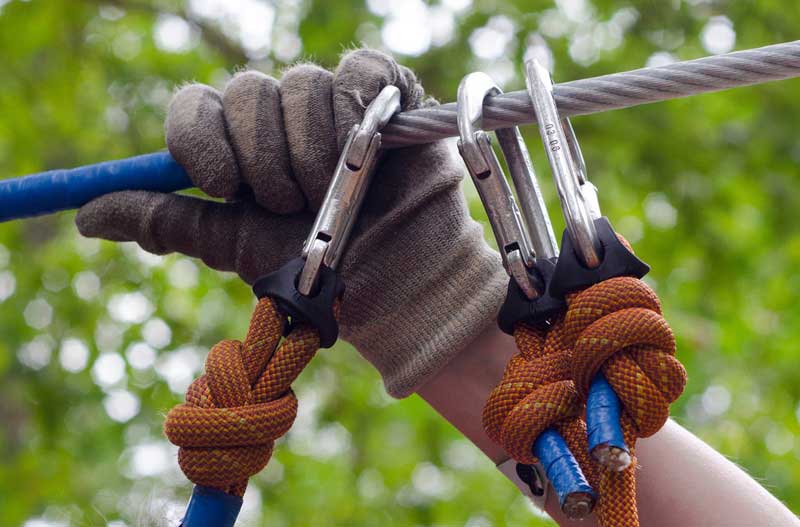
There are other essential pieces of rappelling work equipment – carabiners and slings. Petzl rappel carabiners are excellent as they provide the same functionalities as the traditional carabiner.
However, they are less bulky and lighter than a standard carabiner, thanks to the aluminum alloy material. While there’s a large market for these particular carabiners, climbing-related industries and manufacturers, including Petzl, are undoubtedly leading the trend in their production. The popularity of this product is on the rise.
To understand this fully, let’s first look at what rappel carabiners are!
Rappel Carabiners
If you’re rappelling, you’ll already know these things, but here it goes anyway. A nylon-reinforced strap is utilized as a securing device. It allows you to secure various items and objects when attached to a rope or chain.
Now, aluminum carabiners have several openings on them so that you can connect numerous other locking devices.
Typically, the carabiners will open up to expose the locking device. The smaller horizontal cross-brace would be where the locking mechanism is located. You can shop for manually-closing or auto-closing carabiners, as both are available in the market for you to buy.
These particular carabiners have become increasingly popular among the climbers and sporting community in recent years as they’re an excellent alternative to your standard locking carabiner.
Rappel Slings
Rappel sling is an excellent choice for climbers to work with, and they can easily tie knots to secure their descent. There are a few different types of rappel slings, and each one has its style and way of attaching them to your gear.
- Single Sling: The first type is the single sling. It consists of one line with a cross piece on both ends. It would be best if you secure this crosspiece with a stopper clip and then bring the ends of the line up over your head and into place. Make sure to clip the stopper to the line before tightening the entire loop through the clip.
- Double Sling: The next type is the double sling. These slings usually consist of two ropes with a crosspiece on both ends. However, instead of having a stopper clip, the other end of the line goes through a foot loop that forms a circle on the bottom. Then the other end of the rope goes through the top loop. These slings are the most secure ones and can be used in combination with different sling types for heavier ropes.
5. Harness
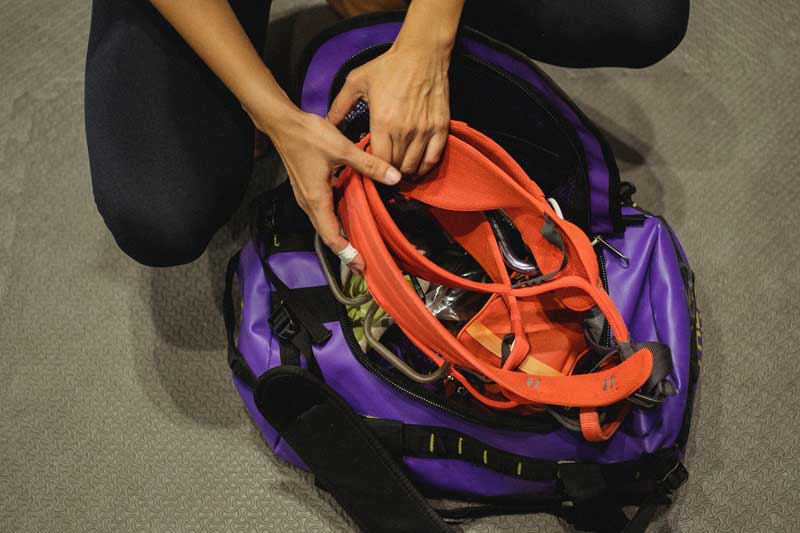
A good rappelling harness has to be adjustable, durable, and comfortable. It should offer multiple gear loops to hold all the necessary equipment needed to rappel off a cliff.
So, how do you decide which one is the harness you should be buying? Should you instantly look on Amazon?
For starters, you need to consider where you will practice your rappelling skills. If you’re just starting and need something light to hang on to, then a one-point harness is perfect for you.
However, suppose you plan on climbing longer or rappelling in more challenging terrain. In that case, you’ll probably want a slightly larger harness size.
Petzl has numerous harness styles to choose from, ranging from a two-point harness with a belay rappel device and a backpack sling up to a one-point harness that doesn’t require a backpack and without a belay device.
The type you choose depends on the kind of climbing you want to do and the environment you’ll be practicing in. Many times, rappelling areas have a steep slope or other obstacles in the path of the climber’s progress.
Therefore, their equipment must be stable enough to handle the climbing force without damaging it.
Most rappelling harnesses also come with different lengths that can accommodate various climbing levels, including small terrain to large cliffs or even more technical climbing.
You should always consider how comfortable your harness is when you’re wearing it. A great rappelling harness is one that fits properly so that your body can move freely and that it doesn’t bind into the fabric of your apparel or boots.
Another consideration when purchasing a new harness is the waist belt size that will go through your hips and pelvic area. If you don’t like the look of the harness you bought, you can simply just take the harness back to the store and get the one that’s more appropriate to your needs.
Lastly, if you’re just starting out, then it’s recommended that you buy a lower-cost model. Of course, suppose your policy is to go shopping for a higher-quality model. In that case, you’ll spend more money on it, but it’ll also last longer, and it’ll provide much better protection, which is, ultimately, what you need.
6. Backup Knot (Prusik Cord)
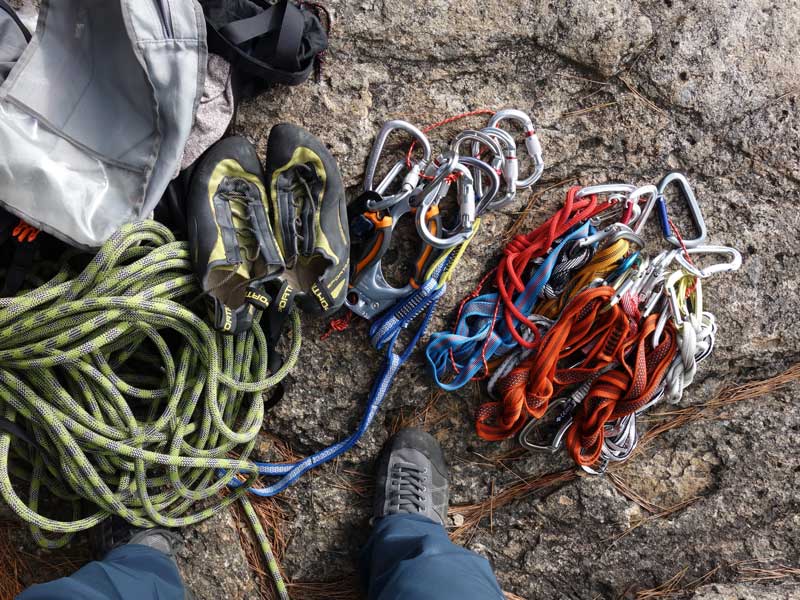
You should tie a rappelling backup knot to prevent your guide or leader from falling during your descent. Many different rappelling knots are used for such situations. All of them have their own particular circumstances under which you should use them and when you should avoid using them.
One of the essential knots to learn in rope-tying is the half-hitch used to lower and raise the safety line. This is an effortless knot with a lot of potential if used appropriately.
Another crucial knot that you have to learn is the single-step loop used when rappelling on a surface that doesn’t offer any fall protection. If this loop is made correctly, it’ll make the line go through the crux, which is the hardest part of the anchor.
The next thing to figure out about this knot is that it can only be used when the climbing guide or leader has a hand on the string. There are many potentials here if the leader uses their free arm, but if one tries to do this without a hand on the line, the entire thing can come crashing down.
Finally, the last rappelling knot you should learn involves the double full-hitch, and it attaches the end of the line to the climber. It also connects one end of the line to the top line and the other end to the bottom of your line.
This little knot allows even distribution of the climber’s weight. Moreover, it can prevent the line from being caught on branches, bushes, or anything else that can cause problems on your way down.
Of course, there are many more great knots to learn, but these will give you an excellent place to start.
7. Clothing
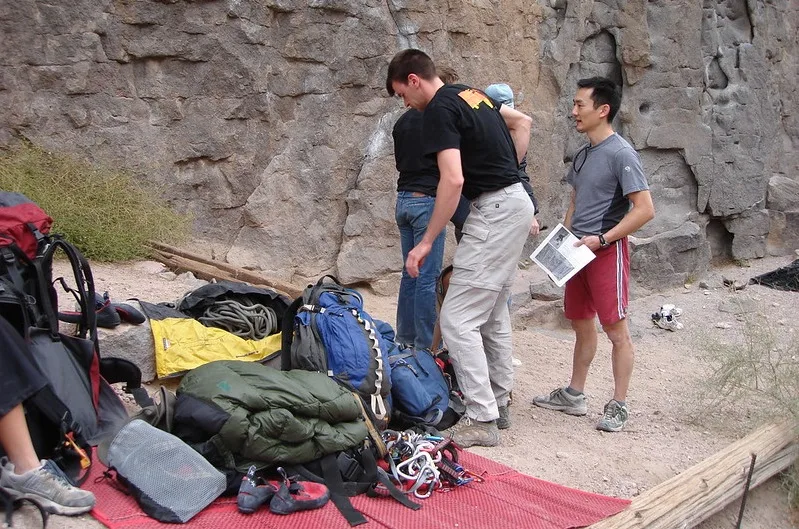
Rappelling clothes are not the same as regular, casual clothes. Instead, they’re specifically designed in bright colors that suit these intense sports that take place at high altitudes under extreme circumstances.
This type of clothing is made from a combination of technical fabric and soft upper material. The material allows the user to maintain a grip on the line even when your body weight is pulling upwards. If you consider that rappelling is a sport requiring you to use all of your strength, you should go in for clothes that’ll provide maximum comfort.
Rappelling clothes are designed to take the stress off of your body while you’re rappelling down a mountain. These clothes allow you to move freely to do more tricks and have more fun. Professional rappelling clothing will assist you immensely in getting more out of your descend.
When looking at clothing for rappelling, the main thing to keep in mind is how light it is. As you may know, rappelling is done using very thin clothing. So, the lighter you dress, the less weight you’ll have to carry during the descent.
With numerous different types of clothing to choose from, there are some things to consider before purchasing. If you’re not entirely sure of what to look for, read on for some tips.
Rappelling Pants
First off, you need a pair of good-quality ripstop pants that won’t restrict your movement. These pants will come with many pockets sewn into them so that you can keep your gear organized.
The most important part of your pants to consider when purchasing is their ability to stretch and how much privacy they offer.
Rappelling requires you to take all of your equipment with you, and if the fabric is too thin, it can easily get stretched out like a rubber band.
After you’ve made sure that your pants won’t be too restrictive and the privacy is there, it’s time to get a good thick line to tie the pants to.
The mono-filament line is an excellent choice as it’s pretty solid and durable. This line is relatively straightforward to fasten and remove from the pants.
When choosing your rappelling pants, your primary focus should be on if the pants fit you well and if they’re strong enough to hold the weight of your body while keeping a good shape.
For this reason, you’ll often find that the tighter and sturdier type of pants is better when first starting out.
In case these pants are too tight for your liking, you have the option to loosen them up a little by taking them off when you need to carry something.
On the other hand, if you want something easier to put on quickly, go for the looseness type of pants, as these allow you to keep a great shape without tightening them up as soon as you reach the top.
Options for such products are widely available on Amazon as well as other brands.
Shirts
Unlike hiking, the shirts that fall under this category are called ledge clothes. These shirts are usually in bright colors instead of black as that helps attract the attention of others during any activity they’re involved in. In addition, some of the shirts come with hoods attached along with other features that make them appealing.
Other features of these shirts include long sleeves that cover the entire arms, collars with laces, and pockets with zipper tops. These shirts are also made from robust ripstop materials that help keep you safe from scratches and getting hurt.
Still, they’re also breathable making them comfortable to wear. Climbing jackets are another type of rappel clothing that professional rappelers prefer to put on.
Sweaters and Jackets
If there is anything worse than the fear or the height during descent is to be trembling, chilly, or damp. Having the appropriate clothes to keep you warm and dry when rappelling may be really beneficial.
Wool is excellent for combining insulation with water-repellent properties, so a wool sweatshirt might be ideal for wearing when rappelling. You should avoid medium-length clothes in terms of fit.
The sweater must either be long enough that you can tuck it in your pants or short enough that it fits behind the harness. You do not want the hem to get caught in any ropes or clips as a result of this.
Hat
While helmets serve the purpose of protecting you against injury, there may be instances where the descent is not that dangerous, but it’s extremely sunny. Hats may help with your visibility while also keeping the sun off your face and neck.
They can also help keep the rain out of your eyes. It is advised to carry a hat with you, regardless of the weather. It’s entirely up to you what kind of hat you choose to wear.
Wide-brimmed headgear is good at holding the sun off the back of the body, but they’re also more difficult to lie flat while packing. Baseball hats address this problem, but they aren’t as protective as they should be.
Another issue to think about is how well your hat is secured on your head. While rappelling you might encounter severe gusts, and you don’t want to be caught off guard.
Sunglasses
When rappelling, sunglasses are essential for guaranteeing adequate visibility. This is due to the possibility of the sun reflecting off the rocks. If you continue squinting during the climb, the sun’s reflection will severely impair your experience.
Similar to hats, you should be mindful that your sunglasses are at risk of falling off your head; purchasing a band to keep them on your head is a smart option.
However, make sure the band isn’t too tight as that might result in a headache. If you can invest in a polarized pair of sunglasses, there cannot be a better product!
8. Gloves
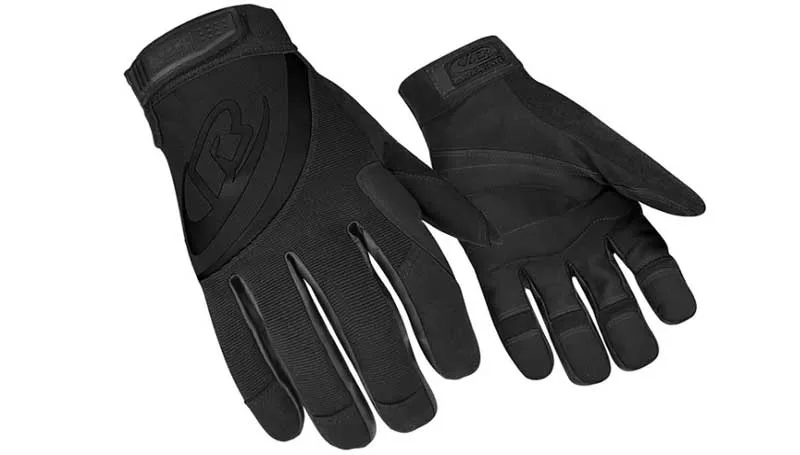
Like all outdoor activities, rappelling also has its share of risks, so successfully protecting yourself against these dangers is quite essential. One of the best ways to protect yourself when descending from cliffs is the policy of wearing suitable gloves. The right ones can protect you from rocks, thorns, and any other danger that you may encounter.
Imagine a situation where you are physically exhausted, your palms are sweaty, or it is unbearably cold. Gripping rope or other equipment can become quite challenging if you do not have suitable gloves.
Rock climbing gear manufacturers now make contact gloves specifically for climbers who are into the sport of rappelling. In addition, they make such gloves of different sizes, shapes, and styles depending on the climb that you’ll be doing. For instance, if you’ll rappel down a very technical route, it’s vital to get the perfect gloves for the type of grip you’ll need.
There are several kinds of specialized rock-climbing contact gloves that you can choose from. Some of these specialized gloves are made for particular activities such as lead climbing, where protection should be more focused on your hands and fingers.
You can also opt to get gloves made explicitly for mountaineering, where protecting your palms and wrists is crucial. Whatever your level of skill is, getting suitable gloves is just as important as carrying the right climbing gear because, without them, your hands are exposed to potential harm.
Amidst all this talk about ‘special gloves’ for ‘special purposes,’ you may wonder where the difference lies and what makes rappelling gloves unique.
Here are a few characteristics that distinguish them:
- Double-padded parts: Rappel gloves are frequently double-padded in high-friction places to extend their durability.
- Fingerless design: You’ll have more maneuverability, whether tying knots or dealing with rope. If you are a photography fanatic or someone who loves sharing their journey on social media, this would greatly assist the usage of any tech you may be carrying.
- Superior fabric: This glove’s material will help you grab ropes better than other gloves and will last longer.
If you’re just going to wear them once in a while or are short on cash but do not want to miss out on an experience – an average pair of gardening gloves would also suffice.
9. Rappel Footwear (Climbing Shoes)
A climbing shoe is specialized footwear designed for climbing, rappelling, and other similar sports. Climbing shoes aren’t the same as hiking shoes (boots) and are mostly made out of leather, synthetic materials, or a mix of both.
Leather climbing shoes are the most commonly used ones as they’re breathable, but they also provide a tight grip on the rock surface.
One of the main features you should search for in climbing shoes is their durability. Your feet will need to absorb significant shock while simultaneously resisting it if you expect to rappel for a long time or otherwise, you’ll need a rescue.
Therefore, when looking to buy comfortable pair of climbing shoes, search for brands that sell shoes with a thick sole. Thick shoe soles will provide a strong platform for your feet and help you avoid blisters and injury.
Some other features to search for in your new shoes include:
- Breathability
- wear and tear resistance
Breathability refers to how well the material wicks away moisture so that your feet don’t get too hot when you’re climbing down. A great feature in sport climbing shoes is an insert that adds bias-tip spikes for added protection against rocks and their edges.
If you’re going to rappel down in a pair of shoes that are a size too big or small, you won’t enjoy the best performance and will likely be less than pleased with the journey. Therefore, choose your shoe size according to the manufacturer’s size charts.
Your climbing shoe needs to have medium asymmetry in the heel and arch. This is called a semi-curved lacing system. It would be great if you also search for a forefoot that is slightly wider than a heel.
The reason for this is when a forefoot is wider than a heel, it becomes more flexible and more stable, but it also adds bias toward the outside of your foot when you’re climbing. All this provides you with much better balance and more control.
10. Head Protection (Helmet)
The most crucial piece of the whole rappelling gear for you to take along is the helmet because head injuries are the most common reason people quit their rappelling activities.
Even though you must wear a helmet when rappelling, you have to choose a helmet that fits you well. Even the slightest difference between two helmets can cause you to get hurt.
An essential feature of your helmet is its breathability. When rappelling, you’re breathing through your mouth, and your face gets very hot. Therefore, you’ll profusely sweat even if it’s not too hot outside, and this can lead your head to overheat.
So, it’s crucial to choose the one that’s both breathable and comfortable to wear. You will find ample of brands on Amazon for good quality head gear.You’ll find plenty of quality helmets on Amazon. We have chosen for you:
A helmet is one of the items of equipment that I believe you should get brand new. Helmets are not meant to withstand repetitive attacks. In reality, your helmet is engineered to break under the pressure of a hard hit. This works similarly to a car’s crumple zone, reducing some of the shocks and shielding your head and neck.
However, suppose you take a significant hit. Your helmet may need to be changed since the absorbing mechanisms within the helmet have been destroyed. When you acquire anything used, especially a helmet, it’s hard to tell what hidden harm has been done to it.
11. Miscellaneous Rappelling Gear: Knife on a Lanyard
Even though most of the gear has been mentioned already, there’s one more thing we’d like to add to this list – a knife on a lanyard.
A knife on a lanyard is a convenient piece of gear and often plays the role of a true life-saver if things don’t go as planned while you rappel. Since the knife is attached to a lanyard, you don’t have to worry about dropping it, and it’s what makes this piece of gear a pretty valuable one. Moreover, it’s easy to get it out of your pocket when needed.
Some people tend to attach this lanyard to their belts or wear it around their necks. Additionally, you can wear this lanyard around your wrist but bear in mind that it might get in the way too much during your descent, so it might not be the best option.
Finally, if you’re thinking of adding this piece of gear to your overall rappelling equipment, be sure to use a smaller knife that Petzl offers. It’s more practical than the bulkier ones.
FAQ
1. What is rappelling in rock climbing?
Rappelling in rock climbing is an exciting activity that involves descending an artificial climbing wall or rock face with ropes, anchors, rappel devices, and other necessary equipment. It’s an increasingly popular extreme sport demanding lots of preparation, knowledge, and physical readiness. Don’t mistake rappelling with abseiling as they’re not the same.
2. What rope is used for rappelling?
The rope used for rappelling is the static rope, and it’s the best one. A static rope has minimal stretching, which provides users with a very smooth descent. Moreover, you can use a dynamic rope to rappel. Still, on your way down, you’ll notice that it can be pretty tricky and complicated, making your descent and overall experience much more dangerous than it should be.
3. Can you rappel with 8mm rope?
Yes, you can rappel with an 8mm rope safely. What’s great is that it doesn’t matter if you’re a big person or not, but it matters if you know how to set up your friction appropriately to accomplish this descent. It’s irrelevant which methods or devices you use for rappelling with 8mm rope. Still, it’s essential to have the knowledge of how to do it properly.
4. How do you rappel without leaving gear?
You can rappel without leaving gear behind by throwing both lines’ ends, one at a time, over the cliff. After throwing them over the edge, make sure that they’ve hit the ground. Then you must tie in your rappel gear so you can lower down both line strands. The Toss ‘n Go works perfectly for shorter descends and rappels in which your rope has at least twice the length of the descent.
5. How do you rappel with a third hand?
You can rappel with a third hand quickly by performing a girth-hitch on your prusik. Put it around the rope at least three times. Then it would help if you utilized a locking biner so you can clip it onto your belay loop. All that’s left to do at this moment is to put your prusik and, ultimately, lock your biner. You can test this method by weighing the hitch while it’s still clipped in.
6. What is a double rope rappel?
A double rope rappel is a situation in which you rappel on two different line strands. Upon reaching a lower rappel station or even the ground, you should then retrieve your line. Retrieving your line is easy. There’s a simple method that requires you to pull on one side of your line, which will ultimately cause the other side to slither through the anchoring system and get down to you.
Conclusion
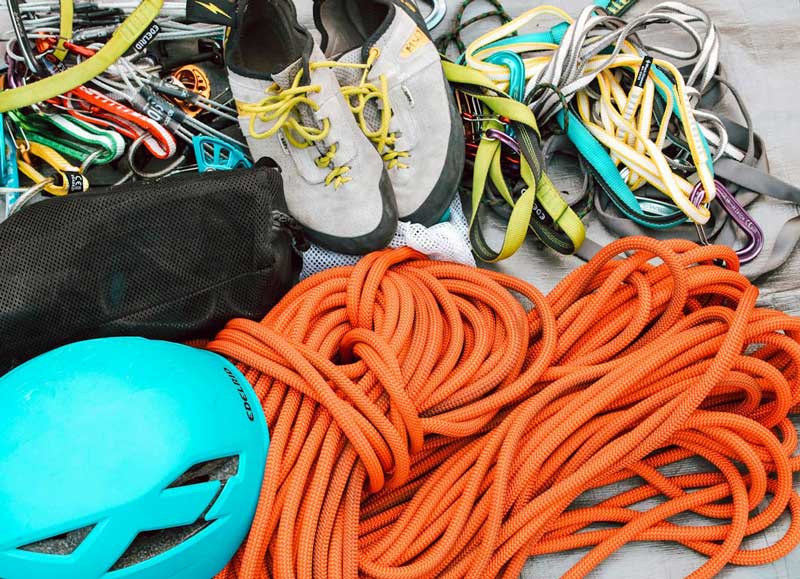
The basic rappelling gear kit usually has around ten essential items like carabiners, lanyards, helmets, gloves, etc.
Still, you can end up using even more items over your basic gear kit if you decide to include things like elbow and knee pads, additional ropes, headlamps, other mounting gear, etc. If so, you’ll end up having a more extensive rappelling kit making your trip a whole lot different.
Some of these items don’t belong to the “basic kit” category. Therefore, they weren’t mentioned so far in this article, but it doesn’t mean you should ignore them.
If you believe that you require more protection and additional equipment for your descend kit, create the list of things and add whatever other gear pieces you desire.
Rappelling is not the primary method to climb down the rock face after you’ve finished climbing it. It’s usually the last resort of every climber.
Rappelling is practiced when the climbers have no alternative to get back down to the ground safely. Regardless, it doesn’t necessarily mean that rappelling must be uncomfortable or scary. If done right, it can be great.
The view is amazing; you do not want this amazing adventure getting ruined by incorrect choices and negligence. Choosing the right gear will ensure your rappelling attempt goes as clean and safe as possible.
If you don’t have a professional rappelling gear retail store in your area, don’t sweat it. Amazon offers an excellent variety of rappelling equipment in 2024, so feel comfortable going and checking them out.


